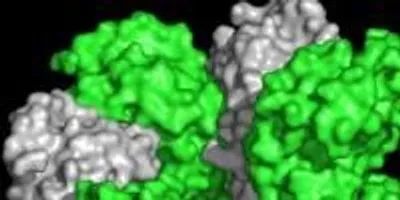 The SLLP1 filament viewed along the side with each neighboring monomer colored alternatively.Figure courtesy University of Virginia School of MedicineCould the sperm harpoon the egg to facilitate fertilization? That’s the intriguing possibility raised by the University of Virginia School of Medicine’s discovery that a protein within the head of the sperm forms spiky filaments, suggesting that these tiny filaments may lash together the sperm and its target.
The SLLP1 filament viewed along the side with each neighboring monomer colored alternatively.Figure courtesy University of Virginia School of MedicineCould the sperm harpoon the egg to facilitate fertilization? That’s the intriguing possibility raised by the University of Virginia School of Medicine’s discovery that a protein within the head of the sperm forms spiky filaments, suggesting that these tiny filaments may lash together the sperm and its target.
The finding, 14 years in the making, has earned the cover of the scientific journal Andrology. It represents a significant step forward in the fine dissection of the protein architecture of the sperm’s acrosomal matrix, an organelle in the sperm head, and suggests a new hypothesis concerning what happens during fertilization.
“This finding has really captured our imagination,” said U.Va. reproduction researcher John Herr of the Department of Cell Biology. “One of the major proteins that is abundant in the acrosome [in the anterior region of the sperm head] is crystallizing into filaments, and we now postulate they’re involved in penetrating the egg – that’s the new hypothesis emerging from the finding, which leads to a whole new set of questions and new hypotheses about the very fine structure of molecular events during fertilization.”
The discovery is the result of a longstanding collaboration between Herr’s lab and the lab of Wladek Minor of the Department of Molecular Physiology and Biological Physics. Years ago, Herr’s lab discovered the protein that has now been shown to form the filaments, which they dubbed sperm lysozyme-like protein 1, or SLLP1. This protein is a member of a family of proteins now known to reside inside the acrosome.
Herr’s lab, however, had no way to determine the shape and structure of the protein. That’s where Minor’s lab came in. To figure it out, Minor’s team had to capture the protein within a static crystal, cool the crystal to cryogenic temperatures to prevent decay and then blast it with X-rays. By examining how those X-rays were refracted, they could calculate the shape of the protein, somewhat like mapping out a shipwreck with sonar.It was no easy task, requiring many attempts and much analysis. But in the end, they were able to produce one of the first descriptions of a sperm protein.
“This is an important protein, because it’s the first crystal structure from a protein within the sperm acrosome,” said Heping Zheng, the lead author of the paper outlining the discovery. “It is also the first structure of a mammalian sperm protein with a specific oocyte-side binding partner characterized. To our knowledge, only nine proteins specifically obtained from mammalian sperm have known structures.”
The new understanding of the structure will now act as a map for Herr and other reproductive biologists exploring how fertilization occurs. “At the very fundamental level, understanding that fine molecular architecture leads me, the biologist, to be able to posit new functions for this family of proteins my lab discovered in the acrosome,” Herr explained.
The structure has been detailed in an article, "Sperm Lysozyme-Like Protein 1 (SLLP1), an intra-acrosomal oolemmal-binding sperm protein, reveals filamentous organization in protein crystal form," published in Andrology by Heping Zheng, Arabinda Mandal, Igor A. Shumilin, Mahendra D. Chordia, Subbarayalu Panneerdoss, John Herr and Wladek Minor.
Could the sperm harpoon the egg to facilitate fertilization? That’s the intriguing possibility raised by the University of Virginia School of Medicine’s discovery that a protein within the head of the sperm forms spiky filaments, suggesting that these tiny filaments may lash together the sperm and its target.
The finding, 14 years in the making, has earned the cover of the scientific journal Andrology. It represents a significant step forward in the fine dissection of the protein architecture of the sperm’s acrosomal matrix, an organelle in the sperm head, and suggests a new hypothesis concerning what happens during fertilization.
To continue reading this article, sign up for FREE to

Membership is FREE and provides you with instant access to eNewsletters, digital publications, article archives, and more.











